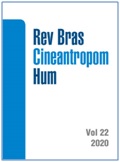Análise de performance no judô: considerações cineantropométricas e biomecânicas
DOI:
https://doi.org/10.1590/1980-0037.2020v22e76584Resumo
Em uma modalidade esportiva de combate tão competitiva como o judô é importante que o treinamento seja planejado minuciosamente para que um atleta possa se destacar no cenário competitivo internacional. Neste contexto, é importante que o treinador e avaliador sejam precisos quanto as medidas realizadas no atleta. Tais medidas, quando corretamente realizadas, podem municiar o treinador com ferramentas que permitam prescrever treinamentos contextualizados. O presente ponto de vista apresentará como variáveis cineantropométricas podem ser consideradas por treinadores e avaliadores ao realizarem análises técnico-táticas e biomecânicas em atletas de judô. Existem diferenças entre sexo e categorias de peso quanto às ações que são predominantes. Categorias mais leves realizam devem realizar treinos específicos quanto ao approach e pegada. Deve-se dedicar atenção a antecipação em atletas das categorias leves e médio. A taxa de desenvolvimento de força é a variável biomecânica mais importante.
Referências
Dal Bello F, Aedo-Muñoz E, Brito CJ, Miarka B. Performance analysis and probabilities by gender in judo: combat phases, techniques and biomechanical levers. Facta Univ Phys Educ Sports 2019;17(1):135-48.
Miarka B, Brito CJ, Amtmann J, Cordova C, Bello FD, Camey S. Suggestions for Judo Training with Pacing Strategy and Decision Making by Judo Championship Phases. J Hum Kinet. 2018;64:219-32.
Ishii T, Ae M, Suzuki Y, Kobayashi Y. Kinematic comparison of the seoi-nage judo technique between elite and college athletes. Sports Biomech. 2018;17(2):238-50.
Miarka B, Sterkowicz-Przybycien K, Fukuda DH. Evaluation of Sex-Specific Movement Patterns in Judo Using Probabilistic Neural Networks. Motor Control. 2017;21(4):390-412.
López Díaz-de-Durana A, Bello Fd, Brito CJ, Miarka B. High level performance in world judo circuit: Notational analyzes of combat phase by weight categories. J Human Sport Exerc. 2018;13(PROC2):S329-S38.
Sterkowicz-Przybycien K, Miarka B, Fukuda DH. Sex and Weight Category Differences in Time-Motion Analysis of Elite Judo Athletes: Implications for Assessment and Training. J Strength Cond Res. 2017;31(3):817-25.
Brito CJ, Miarka B, de Durana ALD, Fukuda DH. Home Advantage in Judo: Analysis by the Combat Phase, Penalties and the Type of Attack. J Hum Kinet. 2017;57:213-20.
Zaggelidis G, Lazaridis S. Muscle activation profiles of lower extremities in different throwing techniques and in jumping performance in elite and novice greek judo athletes. J Hum Kinet. 2013;37(1):63-70.
Pedraza Mejías C, Martínez Cañadas J. Physiological response of the muscular and tendinous conjunctive tissue after application of physical agents. Fisioterapia. 2008;30(6):279-85.
Monteiro LF, Massuça LM, García JG, Carratala V, Proença J. Plyometric muscular action tests in judo-and non-judo athletes. Isokinet Exerc Sci. 2011;19(4):287-93.
McLellan CP, Lovell DI, Gass GC. The role of rate of force development on vertical jump performance. J Strength Cond Res. 2011;25(2):379-85.
Trevino MA, Herda TJ. The effects of training status and muscle action on muscle activation of the vastus lateralis. Acta Bioeng Biomech. 2015;17(4):107-14.
Besomi M, Hodges PW, Clancy EA, Van Dieën J, Hug F, Lowery M, et al. Consensus for experimental design in electromyography (CEDE) project: Amplitude normalization matrix. J Electromyogr Kinesiol. 2020:102438.
Sterkowicz S, Lech G, Sterkowicz-Przybycień K, Chwała W, Ambroży T, Pałka T. Relationship of maximal isometric torque produced in flexors and extensors rate to technique by judo athletes. Acta Bioeng Biomech. 2018;20(2).
Aedo-Muñoz E, Araya-Ibacache M, Miarka B, Moya-Jofre C, Cancino-López J, Mozer RL, et al. Effect of sex differences in sports groups on hamstring flexibility based on the sitreach test: new parameters for Chilean athletes. J Phys Ed Sport. 2019;19(4):2374-8.
Downloads
Publicado
Edição
Seção
Licença

Direitos Autorais para artigos publicados nesta revista são do autor, com direitos de primeira publicação para a revista. Em virtude da aparecerem nesta revista de acesso público, os artigos são de uso gratuito, com atribuições próprias, em aplicações educacionais e não-comerciais, desde que seja dada a atribuição. Esta obra foi licenciada com uma Licença Creative Commons Atribuição 4.0 Internacional - CC BY


